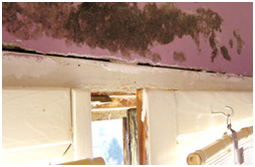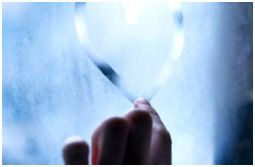Preventing and avoiding appearance of condensation and mold
Because of today's accelerated way of life, noise, technology that surrounds us, when we go into the construction business or residential structure, all of us strive to ensure peace, so we make out of residential structures a real small insulated sealed forts.
Condensation occurs in a well-sealed rooms because the removal of moisture from the room where we reside is prevented. Istraživanja Studies have shown that three people staying in the room produce up to 8 liters of water per day. IIt also cccures in periods of high temperature differences outside in relation to the temperature in the room. Condensation occurs in less protected areas on the edges of the glass, and if such conditions persist for a long time can lead to the mold.

When builing new facilities as well as when renovating older buildings some construction standard must be followed, otherwise it leads to condensation and mold on the walls. Besides That it leads to damage of the building it undermines the quality of housing, but it can also cause serious health problems.
It must be remembered that in all newly built objects a certain percentage of moisture retains and the occurrence of condensation is almost guaranteed, while draining object can last for several years. Inadequate construction also favors the occurrence of condensation because of thermal bridges, as well as inadequate ventilation of the rooms.
It sounds a paradox, given today's technology and advanced construction materials, occurrence of condensation and mold in older buildings is much rarer than in new buildings. The reasons are in use of materials (clay, lime) who had to fill much lower requirements in terms of diffusion of water vapor (the passage of water vapor through a building element of the warmer side of the room to the colder outside).
Zatim, u primijenjenim prozorskim sustavima, kod onih starije izvedbe, kod kojih je brtva znatno lošija (koeficijent propusnosti fuge do 10 m3/mh tj. za 1 sat kroz 1m´ fuge krilo-štok prođe 10 m3 zraka dok 1m´ fuge krilo-štok kod novih prozora za 1 sat propusti u prosjeku 0,1 m3 zraka.
As much as the air change is desirable and has its advantages, a flaw of older buildings is energy consumption. To achieve the proper temperature there is higher consumption of heating energy, and nowadays problems among other is the increasing need for conservation of natural resources and the environment and greater reduction in energy costs. The building must be designed to achieve a better thermal insulation.

No matter how much fun it makes, the occurrence of condensation on the glass of poor PVC profile can cause serious health problems.
Air can absorb a certain amount of moisture (relative humidity, expressed in percentage). Amount of moisture the air can absorb depends on the temperature. The higher the temperature, the air can hold more water vapor, ie. If we heat cold and damp air, it dries out and thus increasing its capacity of absorption of water vapor.
Ventilation of the room introduces fresh and cooler air, and air in a room which is warm and wet dries out , and so can hold more moisture, which normally lasts several hours.
If the ventilation is properly metered occurence of moist air will not happen, and so the creation of condensation on the surface of objects. If the humidity is that high excess moisture stands out and is precipitating. The disadvantage is that just because this air characteristic is causing condensation. When warm air gets in contact with colder surface, it cools and becomes more humid and precipitates at colder surfaces in the form of condensate eg. when you move the bottle from the fridge in a warm room, it will dew.
U-value, ie. thermal transmittance coefficient is the value of the heat flow through the building materials or building structure (in W/m2K). If the U-value is lower insulation is better.
Condensation on the windows occurs easier than on the walls because window has a much larger U-value of a well insulated wall, and the temperature of the inner surface of the window is lower than the temperature of the wall.
Preventing and avoiding condensation on and around windows
- Regular ventilation 2-3 times a day.
- Frequent ventilation of the rooms with increased moisture - bathrooms, kitchens...
- Ventilation systems that are available on the market - a system that is built into the frame of the window. It improve air circulation ensuring a pleasant room climate, is noiseless, windows can be normaly maintained, have no impact on the security systems on windows, installation is simple, invisible, acn be retrofitted, and also can be removed at any time.
Proper ventilation
Includes a wide-open window for a few minutes a day, especially during the heating season. That way the exchange of air is provided. Fresh outside air is heated quickly and can absorb the new amount of moisture, which will get out with the next ventilation. Partialy opening a window during heating season is not very useful because it cools the walls around the windows, which can lead to the absence of condensation but also leads to humidification of the walls. Ventialation is not necessarily only during heating season. It can be performed also during the warmer days without any consequences and with only partially opened window.
Forming of condensation and mold on and around windows
If the external walls of the building are well insulated, sore spots of the building are usually doors and windows because, as already stated, they have a higher heat transfer coefficient compared to walls.
The occurrence of condensation in and on the window can have several causes:
- Bad or inadequate ventilation
- Bad profile system
- The occurrence of thermal bridges when installing windows
- Improper window fugue (the part between the wall and the window or door)
Generally speaking and taking into consideration all factors is not always possible to avoid condensation on windows. In winter at low temperatures condensation can occur even with very good window systems, especially at night. Nevertheless, this should not happen often and can be eliminated by proper ventilation. If these conditions are remedied immediately, the appearance of mold and mildew can be avoided.
Source: Magazine Grad Export